Winter Term in Service - Exploring Teenage Homelessness
March 2, 2010
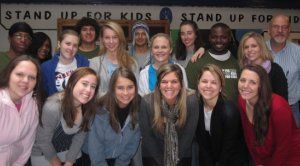 During Winter Term in January, 15 DePauw students dedicated themselves to better understanding issues of homelessness and at-risk teens. The Winter Term in Service (WTIS) trip to San Diego was designed and led by Douglas “Doug” E. Harms, professor of computer science, and Adebayo “Bayo” O. Olowoyeye ’01, instructor of computer science.
During Winter Term in January, 15 DePauw students dedicated themselves to better understanding issues of homelessness and at-risk teens. The Winter Term in Service (WTIS) trip to San Diego was designed and led by Douglas “Doug” E. Harms, professor of computer science, and Adebayo “Bayo” O. Olowoyeye ’01, instructor of computer science.
WTIS was founded at DePauw in 1973 and is based on four components: service, reflection, immersion and education. A unique aspect of the program is student leadership. Students apply and interview for three positions; project intern, reflections intern and education officer. The entire team was selected last spring and met throughout the fall 2009, preparing for the experience.
“One of the great things about WTIS is student leadership,” Harms says. “As faculty members, Bayo and I selected the leaders, and it was a fantastic group. There was so much energy, creativity and passion for the project. We had 15 openings, and 30 students listed us as their first choice. It showed in their dedication and interest in homelessness.”
Paige E. Penrod ’10 and Rebecca “Becca” A. Dray ’10 were student leaders on the trip. Penrod, project intern, and Dray, reflections intern, are WTIS veterans. They met on a 2008 WTIS trip to Cameroon. Victoria “Vicky” S. Googasian ’11 was education officer for the San Diego trip and also participated in a WTIS trip to Costa Rica in 2009.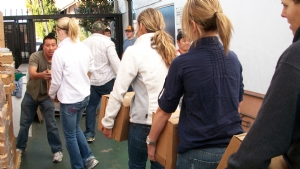
Penrod says she’s not sure how you truly prepare for what they experienced while in San Diego, but they tried. “We had meetings throughout the fall, a retreat and spent time volunteering at the A-way Home Shelter in Greencastle. We did a number of things to familiarize ourselves with homelessness and also with the ethics of service.
“Reading was a big part of the preparation. In the fall, we read To Hell with Good Intentions by Ivan Illich, and Vicky gave a Power Point presentation on trends and legislation of homelessness in the United States and, specifically, in San Diego.
During the trip, they split into three groups, read and discussed the books: Rachel and Her Children by Jonathon Kozol, Tell Them Who I Am by Elliot Liebow, and Reckoning with Homelessness by Kim Hopper.
“We wanted to be conscientious about what we were doing – thinking about our role in San Diego and not just going there and doing service,” Penrod says. 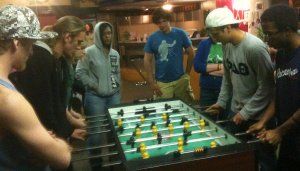 The group stayed at Stand Up For Kids (SUFK), a center for homeless teens. SUFK is open in the evenings and provides free meals, clothing, showers, counseling, and a comfortable place to socialize for homeless and transient teens.
The group stayed at Stand Up For Kids (SUFK), a center for homeless teens. SUFK is open in the evenings and provides free meals, clothing, showers, counseling, and a comfortable place to socialize for homeless and transient teens.
“Our team’s biggest fear was that we wouldn’t be able to interact with the kids – that they wouldn’t want to talk to us,” Penrod says. “We worried that we wouldn’t know how to connect.”
Harms recognized the students’ apprehension but said it didn’t last long after they arrived at the center. “After the first day or two, our students said, ‘Oh, they’re my age.’ They shared music; they had so many things in common.”
At the end of each day, the DePauw team gathered to talk as part of the reflection component. “It was necessary,” Penrod says. “Each day was different for us. Not only were we at Stand Up For Kids, but also we volunteered at a number of other organizations in San Diego that focused on homelessness in different ways: a church that distributed food and a family center where we went every night to help prepare and serve dinner and play with the kids.”
“We also did outreach through SUFK,” Dray says. “We went to Ocean Beach with staff members. There are groups of homeless kids who hang out at the beach. It’s one of the locations volunteers go, four times a week, to distribute donated hygiene and food bags. 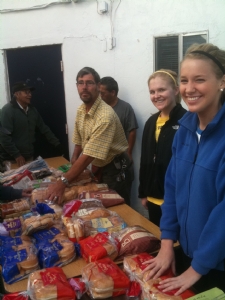
“We talked to the kids and asked them if they knew about the center,” Dray says. “SUFK is discreet. There isn’t a sign on the building, so outreach is a way to let the teens know where the center is located, and that someone is thinking about them.”
“Most of the kids aren’t on the streets because of their own desire. Their home life or foster care is worse,” Penrod says.
“With the kids, they don’t look homeless. They wouldn’t be caught pushing a cart because this is not the life that they want," Dray says. "It just so happens that, for now, they’re stuck. So they’ll carry bags and backpacks so that they’ll look like school kids.
“You won’t come away from the WTIS experience saying, ‘I saved someone.’ We did some direct service – served meals, and completed projects at the center – but it was more of a learning experience."
“Part of what I tried to do with the students was to discuss this idea – in three weeks, we’re not going to solve homelessness, but I hope we make a difference,” Harms says. “Primarily, I still see the experience as learning for us. So, did we get anybody off the streets? I don’t think so. Did we make an impact personally? Maybe.
“I try to approach these trips very humbly. I used to tell people I thought we were going to make a little part of the world a little better. That’s not the right approach. Are we doing more harm than good? There’s an argument that we might be. Those are the kind of discussions that I like to have with the team. Why are we going to San Diego? Why are we doing this? Is it to benefit them or us, or a combination? Are we not sure?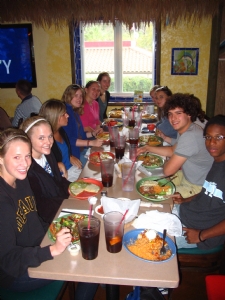 “One of the challenges is how to take the experience in January and apply it after we get back. Once you get back to campus, you’re really excited then all of a sudden, it’s spring semester,” Harms says.
“One of the challenges is how to take the experience in January and apply it after we get back. Once you get back to campus, you’re really excited then all of a sudden, it’s spring semester,” Harms says.
“It’s so easy to forget, and you know that’s going to happen at some point. I think it’s very difficult, if not impossible, to maintain the momentum that you had during Winter Term, but you need to somehow incorporate it into your future experiences.”
Dray agrees. “I think the biggest challenge of the WTIS program is how do we integrate our experiences into our life. The coolest part about this trip is that I think it spoke to students in many different ways because we did so many different things.”
Both Penrod and Dray say the WTIS experience will have long-lasting effects on their lives. Penrod graduates in May with a degree in biochemistry. She will attend medical school in the fall and plans to volunteer at clinics that work with homeless populations.
Dray, an English literature and Spanish double major, graduates in May and will begin Teach for America in Dallas. “I never knew that there is a liaison in public schools who deals with issues of homelessness and transportation issues with families. Now I do.”